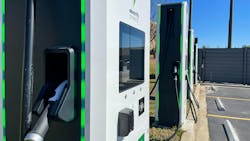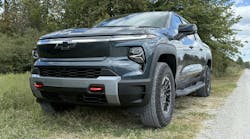How fleet managers can create a resilient EV charging strategy in a shifting market
Key takeaways
- Fleets should match EV charging hardware to specific routes and vehicle types to optimize efficiency.
- Hardware-agnostic software ensures charging operations remain reliable despite vendor changes or tech shifts.
- Piloting or verifying EV hardware and software before full deployment reduces risk and improves long-term fleet performance.
Recent market and policy changes, particularly in the U.S., are creating uncertainty for commercial and municipal fleet owners and operators. Slow public charging infrastructure development has also hampered EV fleet deployment. Analyst Abujayed Miah referred to it as a “chicken and egg” problem—lack of public infrastructure slows overall EV investments, but lagging EV investments further delay infrastructure development.
While accurate, this analysis overlooks deeper complexities of charging infrastructure development. To explore some of those complexities, we can look to private fleets tasked with a balancing act: learning about this new space of electrification and selecting vendors/partners, ensuring their vehicles can still meet business needs, and building cost-effectively and on time.
Fleets that are new to EVs typically begin with vehicle selection and then, as they begin planning their depot, move on to charging hardware selection to complete site design. Software and support often come last and are sometimes an afterthought.
Many new EV entrants feel overwhelmed; a full-stack charging infrastructure provider can feel like an easy answer to this complicated problem. Yet in the past year alone, several major hardware and/or software providers abruptly exited the market, exposing a huge potential vulnerability. Many fleets were left with stranded assets in the form of hundreds of installed or warehoused stations.
EV charging assets should be investments that last for years. Given the turbulent market and policy conditions, here are some basic approaches fleets can take to ensure they are adaptable and resilient.
1. Align EV charging hardware with fleet routes, vehicle types, and operational schedules
Don’t default to a single product or provider. Rather, prioritize solutions that align with real-world usage. For example, a last-mile delivery fleet with long dwell time and predictably short routes may be able to make do with a Level 2 charging station without needing additional power. But if the charging schedule revolves around driver breaktimes or working hours, then charging should be sized accordingly. Selecting the right charging hardware means zeroing in on specific fleet use cases, even if that means mixing and matching vendors.
Realistically, not all fleet vehicles are ready for conversion to electric at the same time because of route constraints or vehicle availability. By the time the fleet is fully converted, the technology and charging hardware market may have significantly evolved. For instance, a fleet may start off with L2 stations for its light-duty service vehicles but two years later identify a more appropriate vendor for the DCFC hardware best suited to its electric drayage vehicles.
Regardless of the configuration of vehicles and chargers, it’s important that all of these different solutions work seamlessly together, which brings us to the next point.
2. Use vendor-neutral software to optimize fleet EV charging, energy management, and telematics
Because of their higher price tags, physical assets like vehicles and charging infrastructure typically receive the highest priority in EV-related commercial and municipal RFPs. But prioritizing hardware over software is like buying the latest devices when you don’t have high-speed internet at home.
Hardware-agnostic software to manage energy, charging, vehicles, and payments ensures operations remain functional regardless of vendor instability and technological changes. Though software is a very small cost component—typically less than 1% of a new charging deployment's total cost—it plays the greatest role in operational success and adaptability over time.
In the short term, software enables fleets to control charging remotely, receive alerts before issues hamper operations, and triage and identify the root cause of technical issues. In the medium term, software allows fleets to review data, notice trends, and analyze and address issues like why Hub A has a much higher utility bill than Hub B, or why Charger 1 has a lower uptime than Charger 2. In the long term, software allows a fleet to weather the changes to the EV landscape by allowing continuity across all Open Charge Point Protocol (OCPP)-compliant hardware.
3. Pilot EV hardware and software to validate performance and ensure long-term fleet compatibility
It’s not uncommon in any rapidly developing industry for hardware or software vendors to make claims that are beyond their true scope. Fleet managers new to electrification could consider pilot periods, or at least demonstrations, with their preferred vendors (vehicle/hardware/software) all participating to ensure compatibility. This allows for real-world testing to determine what works best before locking into a long-term commitment and heavy investment with any one vendor.
That said, while OCPP compatibility is a helpful baseline that can mitigate communication headaches, it’s not enough. It is crucial to also choose products and providers that offer the features and functions most relevant to a fleet’s specific use case: energy management, reporting, analytics, alerting, telematics integrations, access control, LCFS reporting, etc.
By taking the steps outlined above, fleet managers can build an EV charging strategy that is not only scalable but also resilient—ready to adapt to market shifts, emerging technologies, and evolving operational demands.
About the Author

Shana Patadia
Shana Patadia is the head of business development at Synop. She leads the approach to strategic partnerships, complex sales, and business development with a focus on creating a holistic and seamless charging ecosystem for Synop's customers. With a background in energy, Shana has built a career around the electrification of fleets, having previously led the productization of fleet charging software, interfaced with autonomous/carshare/rideshare/eVTOLs, and guided charging hub hardware/software procurement at companies including ChargePoint and EV Realty


